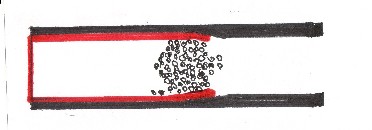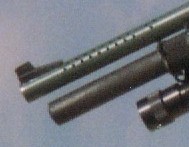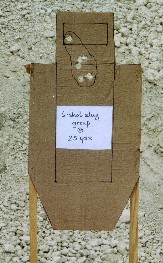| Long Force Coning and Porting |


 |
|
Long Force Coning - Many classic double, pump, and semi-auto shotguns in use today were built and sold in the early 20th century. These early shotguns had chambers of varying lengths and very short forcing cones that were designed to work with shotshells which are now obsolete. These older shotgun shells were made without the protective shot cup common in modern shotshells, requiring a relatively quick seal of the shot column to the bore. Short forcing cones on older shotguns were necessary to ensure that very little gas passed by the shot column as the shot moved from shell to bore, reducing the disruptive effect on the shot column and minimizing negative effect on the shot pattern on impact. Modern shotgun ammunition has its shot column completely protected, usually in a one-piece wad and shotcup, and the short and abrupt forcing cone is no longer necessary. However, with the exception of match-grade shotguns which are long force coned before shipping, most modern shotguns are still built with a short force cone. Better shot patterns can be achieved by lengthening the chamber forcing cone so the shot column undergoes less distortion as it is forced from shell to bore.
Figure 1 - Cross-section of Short Force Cone showing shot distortion as it enters barrel.
Figure 2 - Cross-section of Long Force Cone showing shot retaining consistent formation as it enters barrel. Long force coning improves hunting shot patterns, providing bird, trap, and skeet shooters with the optimum in even pellet distribution across a 30” target area. In the areas of tactical, law enforcement, and home defense shooting, a compact and controlled impact area becomes even more critical. It is common for at least one pellet from a load of 00 Buck to miss a man-sized target at ranges as close as 15 yards. Under actual defense conditions, an overly broad or erratic shot pattern increases the likelihood of an errant .33 caliber round missing the intended target and striking an innocent bystander, causing serious injury or death. A longer forcing cone also provides the additional benefit of assisting in a smoother transition of the shot column as it moves from shell to bore, allowing chamber pressures to build a bit more gradually. This, in turn, spreads the recoil sensation over a longer period of time, resulting in lower felt recoil to the shooter. * * * * * *
|
|
Porting the muzzle of the shotgun has the very positive effect of reducing muzzle rise, allowing quicker target reacquisition. It also lessens the shooter’s felt recoil, giving a more comfortable shooting experience - a real plus for shooters of smaller stature or those who are recoil sensitive.
Figure 3 - Porting on a combat-style Remington 870 shotgun. In recent ‘before and after’ tests on her own gun, an experienced lady shooter who is 5’2” and 110 pounds said she found that porting made her home defense 870 easier to handle and more comfortable to shoot, with less felt recoil, decreased muzzle ‘bounce’, and quicker target reacquisition. Her husband, an experienced former shotgun competitor, found that the porting allowed him to place six slugs in the center mass of this Paladin-style target in 2.9 seconds from 25 yards – a full second faster than before the porting
Figure 4 - Paladin-style target showing six slugs placed in center mass in 2.9 seconds from 25 yards. * * * * * *
|
Click here to return to the Shotgun page.




 and
and  members, active duty military personnel, law enforcement officers, and to
members of any state or local firearms/2nd Amendment support group or association.
members, active duty military personnel, law enforcement officers, and to
members of any state or local firearms/2nd Amendment support group or association.